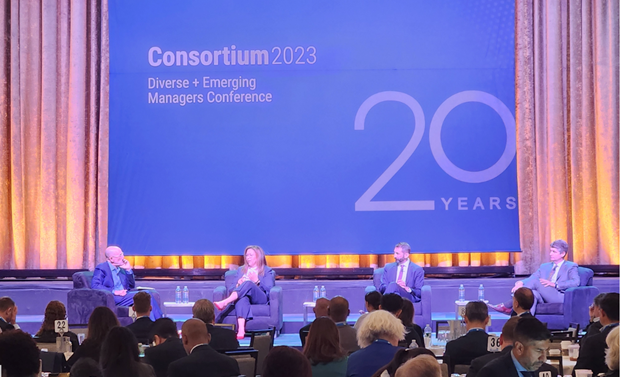In response to George Floyd’s tragic death, many prominent institutions from state pensions, to foundations, and fund managers made bold statements emphasizing the need to make diversity and inclusion a higher priority, not only as it relates to internal hiring, but also in making more substantial direct investments in minority and women owned operators. Now, three years later, how have they done? According to a set of capital allocators speaking at the GSM Grosvenor’s 20th Annual Consortium highlighting diverse and emerging investment managers, the results have been anything but impressive.
But why? Was it all superficial posturing? Has inflation and a softening economic landscape shifted priorities? Did these executives under-estimate the challenges associated with building a talent pipeline? The three panelists should be credited for sharing their views about a topic often too uncomfortable for finance professionals to discuss openly and transparently.
Kresge Foundation’s John Barker pointed out that the lack of diversity in investment management is actually counter-intuitive given exhaustive data around how much it contributes to investment returns. “What we found is that 98.6% of assets are managed by white men. We found 90% of senior money managers are white. 80% of senior leadership positions are held by men. As we dug in further, we found there was no reason for this because when you dive into the research you find that diverse teams make better decisions. That’s empirical. Scott Page (professor) at the University of Michigan has done plenty of work on that. You have found that diverse owned firms perform as well, if not better. I encourage anyone that still questions that go to the Institutional Allocators for Diversity and Inclusion (https://iadei.org ) You can find 100 papers that talk about that in all asset classes.”
Andrew Junkin of Virginia’s Retirement System echoed the sentiment. “In private markets in particular, it’s always about searching for talent. We tend to build relationships slowly. We date a long time. But once we get into a partnership with a firm, we tend to be there a long time. For us, the Consortium experience is about accelerating our ability to identify that talent.”
It goes without saying that pension funds, endowments, and foundations wield immense power in the financial service industry, often individually allocating billions of dollars to many of the world’s largest private equity, hedge funds, and asset management firms. But what then, prevents more allocators from taking a proactive stance like Junkin? Barker suggested that pragmatism often wins the day.
“We (Kresge) survey our current investment partners,” he explained. “We want to know their demographics and track it over time. We tell them to make better decisions they should diversify their teams. And we have 14% that we call the get off our lawn cohort that basically refuses to engage in any way with us. It won’t surprise you the 14% are predominantly almost all lead by white males and it won’t surprise you that these tend to be firms that perform incredibly well. So, the issue we are struggling with is what to do with that 14%. We do have a fiduciary duty to earn the highest returns and for the most part this group performed incredibly well. However, this refusal to engage and acknowledge diversity perplexes us and frustrates us.”
The role consultants play in the investment supply chain also highlights another perennial roadblock. Despite the fact allocators may philosophically believe that diversity is important, if the advisors they rely upon to identify firms to invest in don’t prioritize it, then their visibility to diverse talent will always be limited. Moderator Robert Raben elaborated. “There are virtually no public examples of an allocator or an institution firing an investment manager or consulting firm for failing to perform on diversity. So, there is in many organization exhortations of interest about inclusion of women and people of color…extremely little execution upon that. In other areas of life, people talk about values that are not executed upon, and something happens. Here, we’ve only had one example, I think it was Riverside Church, that let go of Cambridge for its inability to execute upon diversity and Riverside was fairly public about that. People need to say, and you don’t need to publicly execute somebody, but if it is a value that you hold dear, there needs to be a willingness to say this institution was not able to meet that value and we moved on. I don’t think there is shame in that. But for some reason, I don’t think we’re there yet.”
Unfortunately, at its core long-held perceptions around the inability of diverse sponsors to generate competitive returns that continues to stymy progress. Raben explained. “Morgan Stanley put out an attitudinal study in the fall of 2021 and one of the findings was they interviewed about 350 allocators, each of whom is responsible for over $500 million or more. 70% of white allocators told the surveyor that diversity that is important, but it sacrifices returns. You would think that at least for Morgan Stanley or others you would have a code blue crisis. 70% of people admit to an interviewer something that is counter factual. The data does not say that at all. It says the opposite. So, notice what just happened. We have this strong belief according to the survey, that the majority of people in charge disbelieve the talent of the people we are trying to recruit into the system.”
After Raben’s statement, an uncomfortable hush came over the audience and panel. Barker seemed visibly put off by the finding. “The number shocks me. Again, I reference the Institutional Allocators for Diversity and Inclusion website. 100 studies. There are four that make that point, that it is concessionary capital. The other 100-odd say that diverse owned firms perform as well or better, so as a fiduciary I can’t comprehend saying that when I see data that says otherwise.” He highlighted the irony that Morgan Stanley, the very company that conducted a survey on diversity, was evidently as prone to internal bias as the institutions they interviewed. “James Gorman is talking about retirement. No women succession candidates. If you look at the Morgan Stanley senior leadership team, it’s 80% white, 75% male. So, when I hear you talk about this survey you have a massive Wall Street firm that should be at the center of diversity and yet their statistics are as bad as when Kresge started this in 2016. That fundamentally baffles me, that they have had at least 7-10 years and have done nothing.”
For both Barker and Junkin, allocators cannot expect change to occur without taking a leadership role in shifting the cultures of their organizations. Junkin explained. “I think that’s where being in my position, where I can continue to press upon that issue to highlight why would there be some inherent ability of a white man to generate superior returns? What genetic pre-disposition is there? The last time I was here I tiptoed up to the line of saying that that was a racist position and people who hold that belief are racist, but it is. Right? If we believe talent is everywhere and our duty is to generate high returns, this is really a talent acquisition mission. And for us, that means it’s harder than just returning phone calls. You have to be proactive. You have to come to places like Consortium and come with the intent of looking for talent knowing that this is a talent rich environment.
Joyce Foundation’s Nickol Hackett took a different approach to the conversation, arguing the Morgan Stanley survey and others like it are a distraction. “Why is the question asked? I don’t even understand the question. That’s not the starting point of the conversation. It’s not a do they or don’t they (believe diversity is important). Just start with this is going to be our practice. We are starting with looking for the most inclusive, differentiated, high performing portfolio. That’s the starting point. We are not looking for can managers outperform, what managers outperform, we just start from a place that it is going to be inclusive. And we’re not looking to prove or disprove. If you start with the right mindset that we are looking to find the best talent, you will find it. If you’re not looking for the talent, you’re not going to find it. You have to be purposeful in this process.”
When pressed by Raben on what allocators can do to increase their performance, Hackett doubled down on her prior sentiments. “Start by assuming the talent is there. That’s your base case assumption. Assume that people will perform and you could be positive catalytic capital. Make sure you have an inclusive team. People are going to find strategies where others aren’t looking. And if you have a homogenous team, you will have homogenous results, which are subpar.”
For Barker, it centered around being deliberate about building an ecosystem well-aligned with organizational values. “Start with your GPs (general partners). They need to understand that diverse teams make better decisions. Most of the funds we invest with either come through our network or they come from spinouts of our current partners. If there isn’t diversity amongst our current partners, it’s unlikely there will be a spin-out that is diverse. And whatever they say, don’t let them blame the pipeline. That’s a fundamental falsehood. Make them explain it. They’re all going to blame the banks. But we were 93% white, 71% male in 2016, today we are 46% male and 69% white. We recruited from Michigan, Chicago, Northwestern. We got 95% white male candidates. We tore that down. It’s the same philosophy. We apparently invest with the smartest people in the world, but they can’t put some thought into how they can solve this pipeline problem? That’s wrong. Push your current partners.”
Raben instructed institutions to fight pragmatism with pragmatism. “Talk about why it matters to you. And to the extent you can, align incentives. Tie compensation to something, whatever that thing is, and it starts to matter a lot more to people. People do what you pay them to do.”
What is clear, and disappointing, is that the investment management industry is at an impasse and must reconcile whether its support of diversity and economic equity is largely symbolic or rooted in decisive action that can sustainably enhance returns and expand the distribution of wealth creation opportunities for women and minorities. While the input of the panel offered a sobering reminder of this, it also provided a helpful pathway for institutions that want to marry their ideals to their deeds.
Written by Vernon Beckford at [email protected]



